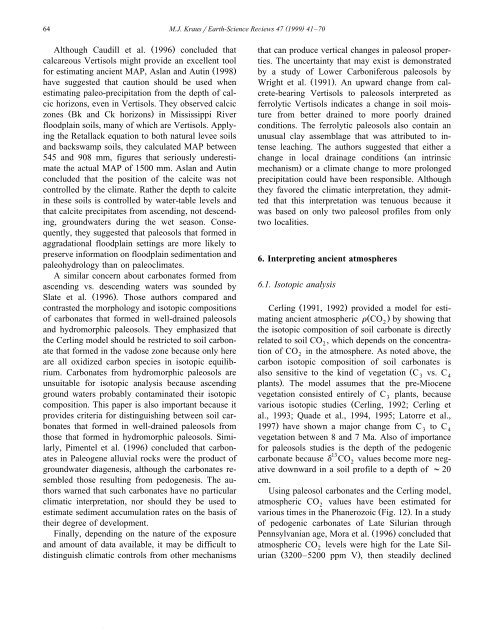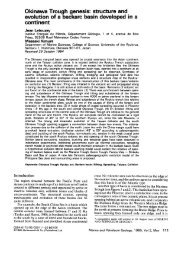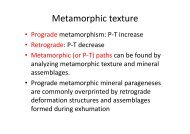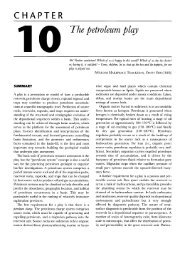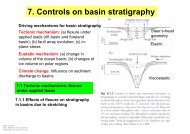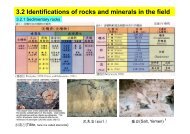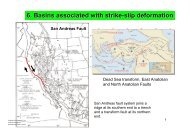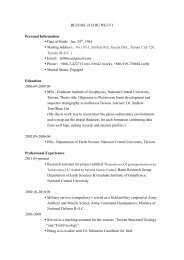Paleosols in clastic sedimentary rocks: their geologic applications
Paleosols in clastic sedimentary rocks: their geologic applications
Paleosols in clastic sedimentary rocks: their geologic applications
- No tags were found...
Create successful ePaper yourself
Turn your PDF publications into a flip-book with our unique Google optimized e-Paper software.
64( )M.J. KrausrEarth-Science ReÕiews 47 1999 41–70Although Caudill et al. Ž 1996.concluded thatcalcareous Vertisols might provide an excellent toolfor estimat<strong>in</strong>g ancient MAP, Aslan and Aut<strong>in</strong> Ž 1998.have suggested that caution should be used whenestimat<strong>in</strong>g paleo-precipitation from the depth of calcichorizons, even <strong>in</strong> Vertisols. They observed calciczones Ž Bk and Ck horizons.<strong>in</strong> Mississippi Riverfloodpla<strong>in</strong> soils, many of which are Vertisols. Apply<strong>in</strong>gthe Retallack equation to both natural levee soilsand backswamp soils, they calculated MAP between545 and 908 mm, figures that seriously underestimatethe actual MAP of 1500 mm. Aslan and Aut<strong>in</strong>concluded that the position of the calcite was notcontrolled by the climate. Rather the depth to calcite<strong>in</strong> these soils is controlled by water-table levels andthat calcite precipitates from ascend<strong>in</strong>g, not descend<strong>in</strong>g,groundwaters dur<strong>in</strong>g the wet season. Consequently,they suggested that paleosols that formed <strong>in</strong>aggradational floodpla<strong>in</strong> sett<strong>in</strong>gs are more likely topreserve <strong>in</strong>formation on floodpla<strong>in</strong> sedimentation andpaleohydrology than on paleoclimates.A similar concern about carbonates formed fromascend<strong>in</strong>g vs. descend<strong>in</strong>g waters was sounded bySlate et al. Ž 1996 .. Those authors compared andcontrasted the morphology and isotopic compositionsof carbonates that formed <strong>in</strong> well-dra<strong>in</strong>ed paleosolsand hydromorphic paleosols. They emphasized thatthe Cerl<strong>in</strong>g model should be restricted to soil carbonatethat formed <strong>in</strong> the vadose zone because only hereare all oxidized carbon species <strong>in</strong> isotopic equilibrium.Carbonates from hydromorphic paleosols areunsuitable for isotopic analysis because ascend<strong>in</strong>gground waters probably contam<strong>in</strong>ated <strong>their</strong> isotopiccomposition. This paper is also important because itprovides criteria for dist<strong>in</strong>guish<strong>in</strong>g between soil carbonatesthat formed <strong>in</strong> well-dra<strong>in</strong>ed paleosols fromthose that formed <strong>in</strong> hydromorphic paleosols. Similarly,Pimentel et al. Ž 1996.concluded that carbonates<strong>in</strong> Paleogene alluvial <strong>rocks</strong> were the product ofgroundwater diagenesis, although the carbonates resembledthose result<strong>in</strong>g from pedogenesis. The authorswarned that such carbonates have no particularclimatic <strong>in</strong>terpretation, nor should they be used toestimate sediment accumulation rates on the basis of<strong>their</strong> degree of development.F<strong>in</strong>ally, depend<strong>in</strong>g on the nature of the exposureand amount of data available, it may be difficult todist<strong>in</strong>guish climatic controls from other mechanismsthat can produce vertical changes <strong>in</strong> paleosol properties.The uncerta<strong>in</strong>ty that may exist is demonstratedby a study of Lower Carboniferous paleosols byWright et al. Ž 1991 .. An upward change from calcrete-bear<strong>in</strong>gVertisols to paleosols <strong>in</strong>terpreted asferrolytic Vertisols <strong>in</strong>dicates a change <strong>in</strong> soil moisturefrom better dra<strong>in</strong>ed to more poorly dra<strong>in</strong>edconditions. The ferrolytic paleosols also conta<strong>in</strong> anunusual clay assemblage that was attributed to <strong>in</strong>tenseleach<strong>in</strong>g. The authors suggested that either achange <strong>in</strong> local dra<strong>in</strong>age conditions Žan <strong>in</strong>tr<strong>in</strong>sicmechanism.or a climate change to more prolongedprecipitation could have been responsible. Althoughthey favored the climatic <strong>in</strong>terpretation, they admittedthat this <strong>in</strong>terpretation was tenuous because itwas based on only two paleosol profiles from onlytwo localities.6. Interpret<strong>in</strong>g ancient atmospheres6.1. Isotopic analysisCerl<strong>in</strong>g Ž 1991, 1992.provided a model for estimat<strong>in</strong>gancient atmospheric rŽ CO .2 by show<strong>in</strong>g thatthe isotopic composition of soil carbonate is directlyrelated to soil CO 2, which depends on the concentrationof CO2<strong>in</strong> the atmosphere. As noted above, thecarbon isotopic composition of soil carbonates isalso sensitive to the k<strong>in</strong>d of vegetation ŽC 3 vs. C 4plants .. The model assumes that the pre-Miocenevegetation consisted entirely of C 3 plants, becausevarious isotopic studies ŽCerl<strong>in</strong>g, 1992; Cerl<strong>in</strong>g etal., 1993; Quade et al., 1994, 1995; Latorre et al.,1997.have shown a major change from C 3 to C 4vegetation between 8 and 7 Ma. Also of importancefor paleosols studies is the depth of the pedogeniccarbonate because d 13 CO2values become more negativedownward <strong>in</strong> a soil profile to a depth of ;20cm.Us<strong>in</strong>g paleosol carbonates and the Cerl<strong>in</strong>g model,atmospheric CO2values have been estimated forvarious times <strong>in</strong> the Phanerozoic Ž Fig. 12 .. In a studyof pedogenic carbonates of Late Silurian throughPennsylvanian age, Mora et al. Ž 1996.concluded thatatmospheric CO2levels were high for the Late SilurianŽ 3200–5200 ppm V ., then steadily decl<strong>in</strong>ed


